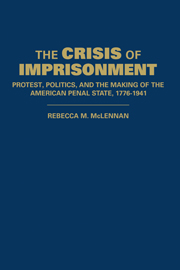Book contents
- Frontmatter
- Contents
- Acknowledgments
- Introduction: The Grounds of Legal Punishment
- 1 Strains of Servitude: Legal Punishment in the Early Republic
- 2 Due Convictions: Contractual Penal Servitude and Its Discontents, 1818–1865
- 3 Commerce upon the Throne: The Business of Imprisonment in Gilded Age America
- 4 Disciplining the State, Civilizing the Market: The Campaign to Abolish Contract Prison Labor
- 5 A Model Servitude: Prison Reform in the Early Progressive Era
- 6 Uses of the State: The Dialectics of Penal Reform in Early Progressive New York
- 7 American Bastille: Sing Sing and the Political Crisis of Imprisonment
- 8 Changing the Subject: The Metamorphosis of Prison Reform in the High Progressive Era
- 9 Laboratory of Social Justice: The New Penologists at Sing Sing, 1915–1917
- 10 Punishment without Labor: Toward the Modern Penal State
- Conclusion: On the Crises of Imprisonment
- Select Bibliography
- Index
10 - Punishment without Labor: Toward the Modern Penal State
Published online by Cambridge University Press: 18 August 2009
- Frontmatter
- Contents
- Acknowledgments
- Introduction: The Grounds of Legal Punishment
- 1 Strains of Servitude: Legal Punishment in the Early Republic
- 2 Due Convictions: Contractual Penal Servitude and Its Discontents, 1818–1865
- 3 Commerce upon the Throne: The Business of Imprisonment in Gilded Age America
- 4 Disciplining the State, Civilizing the Market: The Campaign to Abolish Contract Prison Labor
- 5 A Model Servitude: Prison Reform in the Early Progressive Era
- 6 Uses of the State: The Dialectics of Penal Reform in Early Progressive New York
- 7 American Bastille: Sing Sing and the Political Crisis of Imprisonment
- 8 Changing the Subject: The Metamorphosis of Prison Reform in the High Progressive Era
- 9 Laboratory of Social Justice: The New Penologists at Sing Sing, 1915–1917
- 10 Punishment without Labor: Toward the Modern Penal State
- Conclusion: On the Crises of Imprisonment
- Select Bibliography
- Index
Summary
Thus ends a condition of practical slavery.
Julia Jaffray, General Federation of Women's Clubs, 1936Early on the afternoon of November 7, 1917, a thousand Sing Sing convicts gathered in the prison yard, along with some thirty guests, to hear a series of speeches by New York Governor Charles Whitman, former U.S. attorney general George Wickersham, Warden William Moyer, and a handful of other distinguished officials. As the stars and stripes flapped in the breeze, the thirty convict musicians of Sing Sing's “Aurora Band” marched into the yard in their sparkling white uniforms and delivered a military rendition of the “Star Spangled Banner.” The audience raised its collective gaze toward the sixth floor of the famous old cellblock, where a single slab of stone measuring six by seven by three feet had been dislodged and secured by a heavy rope to a derrick boom. After briefly addressing the crowd, the Governor seized the rope and slowly lowered the slab onto a rail cart stationed 100 feet below. As it came to a rest on the cart, Whitman quipped, “It took a long time to come down.” Major James C. McGuire, the state's prison engineer, then pried a chip from the great stone slab using a long steel bar and presented both to the Governor with the somber, if somewhat awkward, words: “This is the first stone from the cell block of Sing Sing Prison and the bar which did the work I present to you.”
- Type
- Chapter
- Information
- The Crisis of ImprisonmentProtest, Politics, and the Making of the American Penal State, 1776–1941, pp. 417 - 468Publisher: Cambridge University PressPrint publication year: 2008



